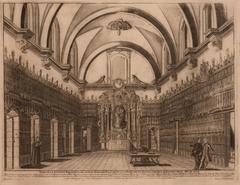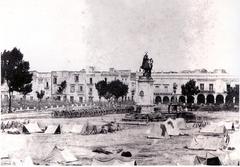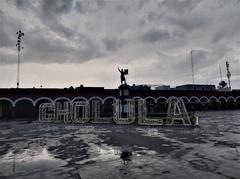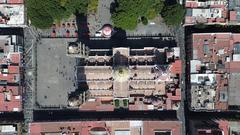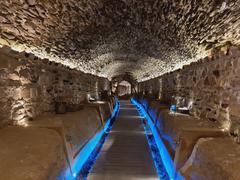
Comprehensive Guide to Visiting Puebla City, Puebla, Mexico
Date: 14/08/2024
Captivating Introduction
Ever wondered about a city where angels descended to lay out its streets, a place that has been a silent witness to revolutions, battles, and culinary innovations? Welcome to Puebla City, Puebla, Mexico, a living testament to the rich tapestry of Mexican history and culture. Founded on April 16, 1531, by Spanish settlers, Puebla is not just another colonial city; it’s a meticulously planned viceregal masterpiece (Wikipedia). The legend of Bishop Julián Garcés and his divine vision of angels tracing the city’s layout gives Puebla its original name, Puebla de los Ángeles, and its current nickname, Angelópolis (Wikipedia).
From the grandeur of its colonial architecture adorned with Talavera tiles to the epic Battle of Puebla that gave birth to Cinco de Mayo, the city is a historical and cultural treasure trove (History.com; Britannica). Today, Puebla’s well-preserved Baroque-style architecture has earned its colonial center the status of a UNESCO World Heritage site (Britannica). But Puebla isn’t just about history; it’s a buzzing metropolis that’s a hub for industry, education, and culinary arts. Imagine tasting mole poblano and chiles en nogada, iconic dishes that find their roots in this very city (TripSavvy).
With each cobblestone whispering tales of yesteryears, Puebla offers a unique blend of the past and the present, a city where every street corner is a narrative waiting to be discovered. Whether you’re drawn by its historical significance, architectural marvels, or culinary delights, Puebla City promises an unforgettable journey that engages all your senses.
Table of Contents
- Historical Overview
- Visitor Tips
- Call to Action
Historical Overview of Puebla City, Puebla, Mexico
Founding and Early History
Imagine a city where angels are believed to have descended from heaven to lay its streets. Welcome to Puebla, a city steeped in legend and history. Founded on April 16, 1531, by Spanish settlers, Puebla City, formally known as Heroica Puebla de Zaragoza, was established in the Valley of Cuetlaxcoapan. Unlike many other colonial cities in Mexico, Puebla was a planned viceregal city, designed as a strategic midway point between Mexico City and the port of Veracruz (Wikipedia).
According to legend, the city’s location was chosen based on a divine vision experienced by Bishop Julián Garcés of Tlaxcala. He reportedly saw a valley with woods, meadows, and a clear river, where angels descended from heaven to trace out the city’s layout. This heavenly vision led to the city’s original name, Puebla de los Ángeles, and its current nickname, Angelópolis (Wikipedia).
Colonial Era
During the colonial period, Puebla quickly grew in importance due to its strategic location and fertile lands. The city became a vital stop for travelers and traders moving between Mexico City and Veracruz. The Spaniards introduced European agricultural practices, which, combined with the region’s rich volcanic soils, made Puebla a significant center for agriculture and industry (History.com).
Puebla’s colonial architecture is a testament to its historical significance. The city center, laid out in a grid pattern, features numerous colonial-era buildings, many of which incorporate decorative glazed Talavera tiles. These tiles were introduced by early residents from Talavera de la Reina, near Toledo, Spain. Notable structures from this period include the 16th–17th-century Cathedral of the Immaculate Conception, the Church of Santo Domingo with its gold-leafed Chapel of the Rosary, and the Franciscan Convent of Cuauhtinchan (Britannica).
The Battle of Puebla and Cinco de Mayo
One of the most significant events in Puebla’s history is the Battle of Puebla, which took place on May 5, 1862. During this battle, Mexican forces, despite being outnumbered, defeated the French army. This victory is commemorated annually on Cinco de Mayo, a holiday that has become synonymous with Mexican pride and resistance. The celebrations in Puebla include a large parade, re-enactments of the battle, and various cultural activities (History.com).
Modern Era and UNESCO World Heritage Site
In the modern era, Puebla has continued to grow and develop while preserving its rich historical and cultural heritage. The city’s colonial center was designated a UNESCO World Heritage site in 1987, recognizing its well-preserved Baroque-style architecture and historical significance (Britannica).
Puebla has also become an important industrial and educational center. The city is home to several universities and cultural institutions, including the José Luis Bello y González Art Museum and the Museum of Religious Art. Additionally, the discovery of a tunnel system in 2015, believed to be up to 500 years old, has added another layer to the city’s historical intrigue (Wikipedia).
Cultural Significance and Attractions
Puebla is renowned for its cultural contributions, particularly in the fields of art and cuisine. The city is famous for its Talavera pottery, a type of majolica pottery that has been produced in Puebla since the colonial period. This pottery is characterized by its intricate designs and vibrant colors (Discover Puebla).
Puebla’s culinary heritage is equally impressive. The city is the birthplace of several iconic Mexican dishes, including mole poblano and chiles en nogada. Mole poblano, a rich, complex sauce made with chocolate and various spices, is perhaps the most famous of these dishes. Visitors can sample these traditional foods at local restaurants such as Fonda Santa Clara and La Casita Poblana (TripSavvy).
Visitor Tips for Puebla City, Puebla, Mexico
Why Puebla is Your Next Must-Visit Destination
Ever heard of a city where the streets are paved with history, and the air is thick with the aroma of chocolate and chili? Welcome to Puebla City, where every corner has a story, and every meal is a masterpiece.
Best Time to Visit
Puebla, known for its ‘Eternal Spring,’ is a delight all year round. For a perfect blend of pleasant weather and fewer crowds, aim for the shoulder seasons from September to November and April to May. You’ll enjoy the city at its finest without the tourist rush. Avoid December to March if you’re not a fan of long lines and high prices (Chester Travels).
Safety Tips
Puebla is generally safe, but stay street-smart. Stick to well-lit and busy areas at night, and keep an eye on your belongings in crowded spots. Opt for Uber or registered taxis to get around safely (Chester Travels).
Accommodations
First time in Puebla? The Historic Center is your go-to. It’s a treasure trove of attractions like the Zócalo and Puebla Cathedral. Whether you’re on a budget or ready to splurge, you’ll find the perfect spot to rest your head (Discover Puebla).
Getting Around
Exploring the Historic Center on foot is a no-brainer—everything’s within walking distance. For farther destinations, hop on the Turibus. It’s a fun way to see major sights like the Cinco de Mayo forts and the International Museum of the Baroque (Puebla City).
Cultural Etiquette
Respect local customs: dress modestly, especially at religious sites, and brush up on basic Spanish phrases. A simple ‘Buenos días’ or ‘Buenas tardes’ can make a world of difference (Chester Travels).
Must-Try Foods
Puebla’s culinary scene is legendary. Don’t leave without tasting Mole Poblano, a rich, chocolate-chili sauce over chicken. Chiles en Nogada, stuffed peppers topped with walnut sauce and pomegranate seeds, is another must-try. Sweet tooth? Head to Calle de los Dulces for traditional candies like camote and muégano (Culture Trip).
Key Attractions
Historic Center
The Historic Center, a UNESCO World Heritage Site, is a goldmine of colonial architecture. Highlights include the Puebla Cathedral, Capilla del Rosario, and Casa de los Muñecos. Start your journey at the Zócalo (Puebla City).
Museums
Puebla’s museums are top-notch. The Museo Amparo boasts pre-Hispanic and contemporary art, while the International Museum of the Baroque, designed by Toyo Ito, showcases Baroque art and architecture (Discover Puebla).
Natural Attractions
Nature lovers, rejoice! The nearby Popocatepetl and Iztaccíhuatl volcanoes offer breathtaking views and hiking. While Popocatepetl is off-limits due to volcanic activity, Iztaccíhuatl is perfect for climbing. Don’t miss Parque Ecologico and ArboTerra for family-friendly outdoor fun (Culture Trip).
Festivals and Events
Puebla’s festivals are vibrant and unforgettable. Cinco de Mayo in May features parades and reenactments, while Day of the Dead in November is a visual feast of altars and decorations. Book your stay well in advance during these times (Chester Travels).
Shopping
Puebla is famous for Talavera pottery. The Parian Market is the best place to shop for these unique ceramics and other local crafts. Mercado el Carmen is a foodie’s paradise for traditional ingredients (Puebla City).
Day Trips
Take a day trip to Cholula, known for its Great Pyramid and numerous churches. The pyramid, topped with a church, offers panoramic views. Cholula’s nightlife and markets are also worth exploring (Discover Puebla).
Practical Information
Currency and Payments
The official currency is the Mexican Peso (MXN). Credit and debit cards are widely accepted, but carry some cash for small purchases. ATMs are everywhere.
Health and Safety
Drink bottled water only. Travel insurance is a must. Pharmacies are plentiful, and many medications are available over the counter.
Connectivity
Free Wi-Fi is common, but a local SIM card is handy for reliable internet, especially for navigation apps.
Final Tips
- Language: Basic Spanish goes a long way, even though many locals in the tourism industry speak English.
- Tipping: It’s customary to tip 10-15% in restaurants.
- Electricity: Mexico uses Type A and Type B outlets. The standard voltage is 127 V, and the frequency is 60 Hz.
FAQ
Q: Is Puebla City safe for solo travelers? A: Yes, but stick to well-lit and populated areas, especially at night.
Q: What’s the best way to get around Puebla? A: Walking in the Historic Center and using Uber or registered taxis for longer distances.
Q: Can I drink the tap water? A: No, stick to bottled water.
Q: Do I need to know Spanish? A: Basic Spanish phrases are helpful, but many people in the tourism sector speak English.
Call to Action
Download the Audiala app today and let us guide you through the wonders of Puebla City. From hidden gems to culinary delights, your adventure starts here!
Puebla City is a vibrant canvas of history, culture, and modernity, offering an immersive experience that goes beyond the ordinary. From its founding in 1531, driven by what was believed to be a divine vision, to its pivotal role in Mexican history marked by the Battle of Puebla, the city has always been at the crossroads of significant events (Wikipedia; History.com). Its UNESCO World Heritage status attests to the well-preserved colonial architecture that charms every visitor (Britannica).
But what truly sets Puebla apart is its ability to seamlessly blend the past with the present. It’s a place where you can lose yourself in the splendor of colonial-era buildings and then find yourself savoring world-renowned dishes like mole poblano. The city’s cultural contributions, particularly in arts and cuisine, make it a must-visit destination for anyone looking to experience the essence of Mexico (TripSavvy).
Whether you are exploring the hidden tunnels that date back 500 years or participating in the vibrant Cinco de Mayo celebrations, Puebla offers a rich tapestry of experiences that cater to every kind of traveler. The Audiala app can guide you through this enchanting city, offering expert insights and uncovering hidden gems that make your visit truly special. Download Audiala today and let Puebla’s unique blend of history, culture, and modernity captivate you.
References
- Wikipedia, 2023 Wikipedia
- History.com, 2023 History.com
- Britannica, 2023 Britannica
- TripSavvy, 2023 TripSavvy
- Discover Puebla, 2023 Discover Puebla
- Chester Travels, 2023 Chester Travels
- Culture Trip, 2023 Culture Trip
- Puebla City, 2023 Puebla City









